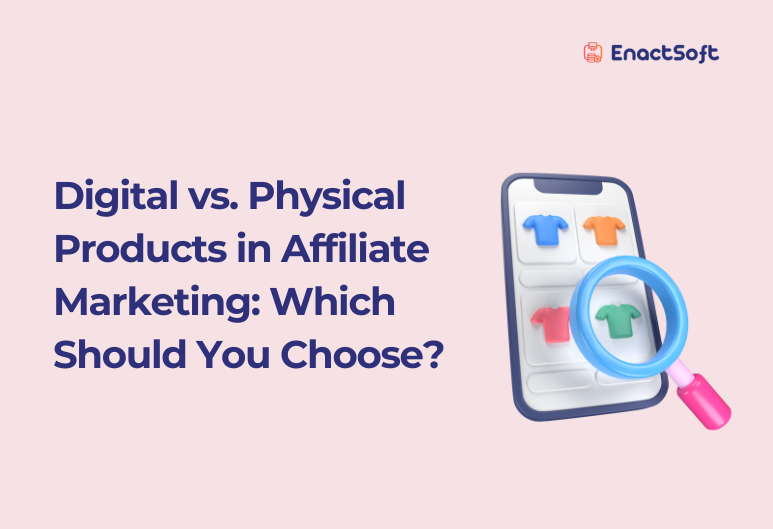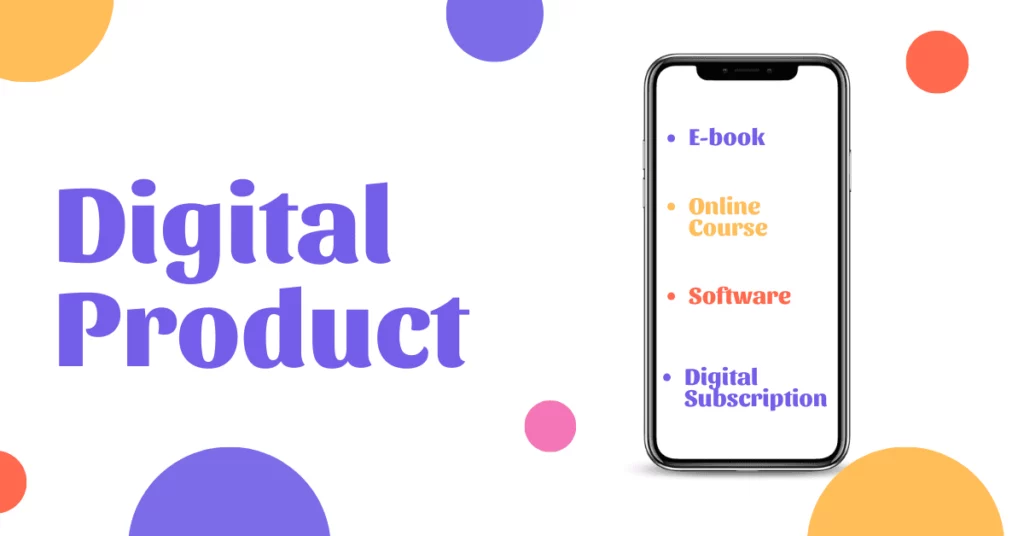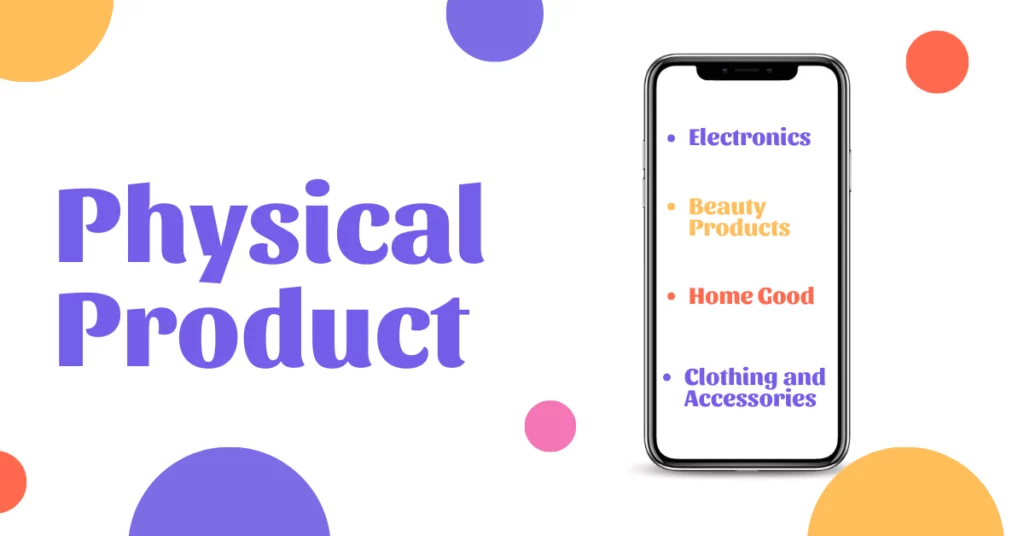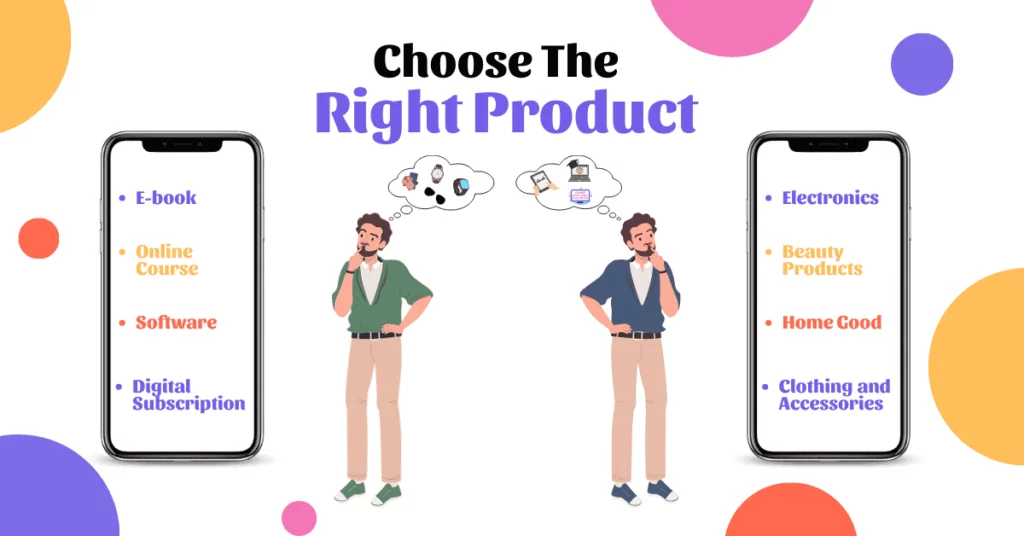
Are you just starting as an affiliate? #
Are you confused about which products to go with, digital or physical?
It can be overwhelming seeing a lot of products available there and attractive commission rates. Affiliates often go for the products with the highest commission rates to earn more money. But many of them end up not doing so well, its because they don’t choose the right product.
In this article, we’ll discuss both digital and physical products, their key differences, pros and cons and so much more. We’ll also provide strategies to promote products and will help you choose how you can choose the right product for you.
Digital Products in Affiliate Marketing #

Digital products in affiliate marketing are items that are delivered electronically, such as e-books, online courses, software, and digital subscriptions. These products offer instant delivery and access, and higher profit margins due to lower production costs. They are also more scalable compared to physical products as they can be sold globally without additional cost.
Get Your Cashback Website Today! #
Whether you are a startup or rapidly growing business get the cashback solutions in few clicks.
Popular Examples of Digital Products #
- E-books: E-books are digital versions of traditional books. They can be read on various devices, including e-readers, tablets, and smartphones. Affiliates often promote e-books on topics ranging from self-help and business to fiction and academic subjects.
- Online Courses: Educational platforms and independent creators offer online courses covering a vast array of subjects. These courses can include video lectures, written materials, quizzes, and interactive elements. Affiliates earn commissions by promoting courses that cater to their audience’s interests and needs.
- Software: Software products range from productivity tools and antivirus programs to graphic design and video editing applications. Software subscriptions or one-time purchases are popular among affiliates who target tech-savvy audiences.
- Digital Subscriptions: These include memberships to online services such as streaming platforms, cloud storage, and news websites. Affiliates can earn recurring commissions by promoting subscription services and providing a steady income stream.
Key Statistics: #
- Digital products account for a significant portion of affiliate marketing revenue. For example, SaaS-based products pay commissions ranging from 20% to 70%.
- On average, affiliate marketing brings a 12:1 return on ad spend (ROAS), which is high for digital products due to lower overhead costs.
- More than 80% of advertisers use affiliate marketing, with a significant focus on digital products due to their scalability and ease of distribution.
- Affiliate marketing accounts for 15% of all online media profits, underscoring the substantial revenue potential of digital products.
Pros of Promoting Digital Products: #
- Instant Delivery and Access: Customers can download or access digital products immediately after purchase. It improves customer satisfaction and reduces delivery issues and cost.
- High-Profit Margins: Digital products often have lower production costs, which results in higher commissions for affiliates.
- No Inventory or Shipping Costs: Affiliates don’t need to worry about stock management or shipping logistics.
- Easier to Scale: Digital products can be sold globally without additional overhead costs.
Cons of Promoting Digital Products: #
- Higher Competition: It’s easy to enter digital product affiliate marketing, thus the market is saturated.
- More Refund Requests and Chargebacks: Digital products can be easily returned, leading to higher refund rates.
- Dependence on Internet Access: Both affiliates and customers need reliable internet access.
- Perceived Lower Value: Some consumers may undervalue digital products compared to physical items.
Strategic Tips for Promoting Digital Products #
- Leverage Expertise: Choose digital products that align with your knowledge and interests. Your expertise can increase credibility and trust with your audience.
- Provide Value: Create content that adds value, like in-depth reviews, tutorials, and case studies. This helps build trust and increase conversions.
- Optimize for SEO: Use search engine optimization (SEO) techniques to drive organic traffic to your promotions. Targeting long-tail keywords can help you reach a more specific audience with less competition.
- Utilize Email Marketing: Build an email list and use it to promote digital products. Personalized recommendations and exclusive offers can drive more engagement and sales.
- Engage on Social Media: Use social media platforms to engage with your audience and promote digital products. Share valuable content, run ads, and interact with followers to build a loyal community.
Physical Products in Affiliate Marketing #

Physical products remain an important part in affiliate marketing due to their demand. These products are items that customers use in their everyday lives, like electronics, clothing, home products and more. They offer value and often have lower refund rates compared to digital products, making them a reliable source of steady commissions for affiliates.
Additionally, physical products cater to a broader audience, enhancing the potential for higher sales volumes.
Popular Examples of Physical Products #
- Electronics: This category includes gadgets such as smartphones, laptops, tablets, and home appliances. Electronics are popular due to their high demand and frequent upgrades.
- Clothing and Accessories: Fashion items like clothing, shoes, jewelry, and accessories have a vast market. Affiliates can cater to various niches within the fashion industry, from high-end luxury brands to everyday wear.
- Health and Beauty Products: This includes skincare products, cosmetics, supplements, and fitness equipment. The health and beauty industry is continually growing, with consumers regularly seeking new products.
- Home Goods: Items such as furniture, kitchen appliances, and decor are evergreen products. Home improvement and DIY niches also fall under this category, appealing to a wide range of consumers.
Key Statistics: #
- Physical products take up a significant portion of affiliate marketing, with retail generating 43% of affiliate marketing revenue.
- The home and garden industry is the fastest-growing physical product category, with a year-over-year growth rate of 209.72%
- 83% of brands recruit new affiliates via network dashboards, many of which promote physical products.
- 76% of content providers find affiliate marketing makes monetization easier, with many focusing on physical products that have broad consumer appeal.
Pros of Promoting Physical Products: #
- Tangible and Perceived Higher Value: Customers often place higher value on physical products they can touch and see.
- Lower Refund Rates: Physical products typically have lower return rates compared to digital products.
- Wider Audience Appeal: Physical products can attract a broader audience, as they are not limited by the need for internet access.
- Established Affiliate Programs: Many well-known retailers, like Amazon, have robust affiliate programs that are easy to join.
Cons of Promoting Physical Products: #
- Inventory and Shipping Concerns: Issues with stock availability and shipping can affect sales and customer satisfaction.
- Lower Profit Margins: Physical products often come with higher production and shipping costs, leading to lower commissions.
- Potential for Damaged Goods: Physical products can be damaged during shipping, leading to returns and refunds.
- Limited Scalability: Logistical limitations can limit the scalability of promoting physical products.
Strategic Tips for Promoting Physical Products #
- Highlight Unique Features: Clearly showcase what makes the product special. Focus on quality, design, or any innovative aspects that set it apart from similar items.
- Use High-Quality Visuals: Invest in professional photos and videos to make the product look appealing. Show it in use to help potential buyers visualize owning it.
- Share Customer Reviews: Display honest reviews and testimonials from real customers. Positive feedback builds trust and can influence others to buy.
- Offer Limited-Time Deals: Create urgency with special discounts or flash sales. Limited-time offers encourage quick purchasing decisions.
- Promote Across Multiple Channels: Use various platforms like social media, email, and blogs to reach a wider audience. Consistent messaging helps reinforce the product’s value and increases visibility.
Key Differences Between Digital and Physical Products #
➢ Delivery and Logistics: Digital products are delivered instantly online, while physical products require shipping and handling.
➢ Commission Structures: Digital products generally offer higher commissions due to lower production costs. Physical products often have lower margins due to higher production and shipping costs.
➢ Target Audience and Market Saturation: Digital products appeal to tech-savvy consumers, while physical products have a broader appeal. However, the digital market can be more saturated.
➢ Product Lifecycle and Trends: Digital products may require frequent updates to remain relevant, while physical products have more extended lifecycles but may be subject to fashion and technology trends.
How to Balance Profit Margins and Potential Earnings? #
When promoting physical products, it’s essential to balance the lower profit margins with the potential for higher volume sales. Although the commission per sale might be lower compared to digital products, the appeal and nature of physical products can lead to higher overall sales.
Affiliates should focus on building a strong, trust-based relationship with their audience and selecting products that align well with their followers’ needs and preferences.
Choosing the Right Product Type for Your Affiliate Marketing Strategy #

➢ Assessing Your Audience’s Needs and Preferences: Understanding your audience is crucial. If they prefer immediate access and digital solutions, digital products may be ideal. If they value tangible items, physical products could be better.
➢ Considering Your Niche and Expertise: Choose products that align with your niche and expertise. For instance, tech bloggers might find more success with digital products, while fashion bloggers might excel with physical products.
➢ Analyzing the Competition and Market Trends: Research your competitors and market trends. High competition in digital products may require a more aggressive marketing strategy, while physical products might offer less competition but require more logistical planning.
➢ Balancing Profit Margins and Potential Earnings: Consider the potential earnings and profit margins. Digital products may offer higher commissions but face higher refund rates, while physical products may offer lower margins but more stable earnings.
Conclusion #
In affiliate marketing, the choice between digital and physical products depends on various factors, including your audience, niche, competition, and profit potential. Digital products offer high-profit margins and scalability but face higher competition and refund rates.
Physical products have broader appeal and lower refund rates but come with logistical challenges and lower margins. Ultimately, the best choice should align with your goals, expertise, and audience preferences.



